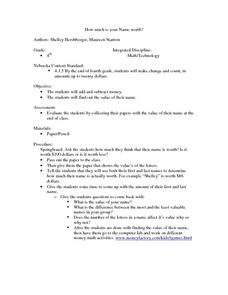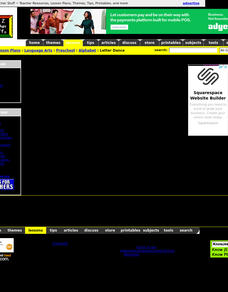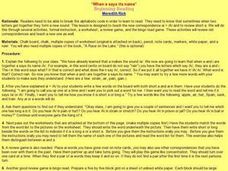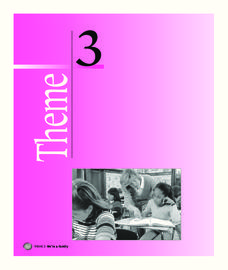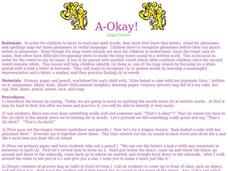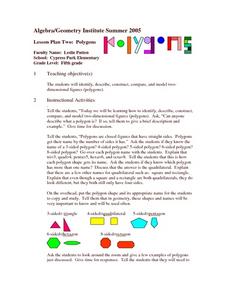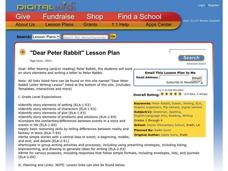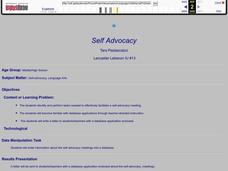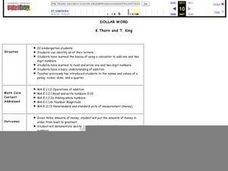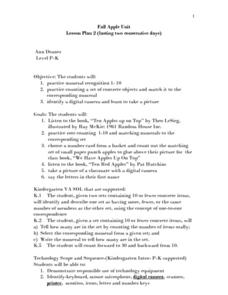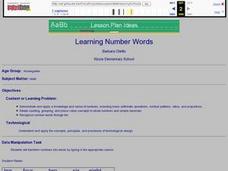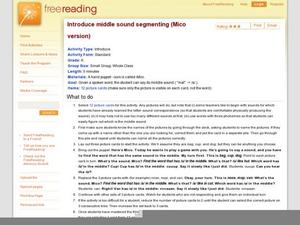Curated OER
Beat the Heat
Review common digraphs with your early elementary schoolers. They identify the digraph /ea/ in written and spoken language. After a brief discussion, they apply the rule for identifying and spelling words containing the /ea/ digraph....
Curated OER
How Much is Your Name Worth?
Students identify the value of each coin type and then use a code to assign each letter of the alphabet to the value of the coins. They add coin combinations to determine the value of their name.
Curated OER
Letter Dance
Students identify the shape of the letter their name begins with, then use their arms to trace the shape of the letters with their hands. They do this to the movement of music.
Curated OER
A My Name Is Alice
Fourth graders brainstorm and research to find information that fits with their assigned letter. They decide with their group which items to be used in their book page. Students participate in the illustration of the group page.
Curated OER
When A Says Its Name
Young scholars are introduced to the concept of vowel digraphs. They identify the digraph /ai/ in spoken language. After a brief discussion, students apply the rule for reading and spelling words containing the /ai/ digraph by playing...
Curated OER
Techno-shapes
Explore the concept of shapes by using tools in Kid Pix Deluxe 4 computer program. This techno-shapes lesson has pupils watching a video about shapes, and using the Kid Deluxe 4 computer program to draw shapes. They get to...
Houghton Mifflin Harcourt
We’re a Family: Extra Support Lessons (Theme 3)
Pay special attention to onsets and rimes and initial consonants with this packet of activities designed to provide additional support to youngsters just learning to read and write.
Houghton Mifflin Harcourt
We’re a Family: English Language Development Lessons (Theme 3)
Teach your English language learners how to talk about their families with three weeks of lessons. Over the course of the thematic unit, learners pick up new vocabulary so that they can talk about families and relationships, clothing,...
Curated OER
Number and Shape Patterns
Review what constitutes a pattern, and have the kids create number and shape patterns of their own. An activity page requires them to name and identify simple numerical patterns.
Curated OER
A-Okay
Learners distinguish between short and long vowel /a/ sounds. They are introduced to the vowel-consonant-e pattern that changes short vowel sounds into long vowel sounds. Then they practice identifying words with the...
Curated OER
Vowel Sounds
This plan aims to increase the reading proficiency of your fourth grade class. While no materials are provided, a list of activities to practice are included. Various activities include creating songs for short vowel sounds, using cue...
Curated OER
Lesson Plan Two: Polygons
Learners explore the concept of polygons on a two-dimensional plane. They identify polygons in everyday life and draw different polygons according to their classification. Using a geoboard and geobands, they consrtuct polygons and even...
Curated OER
Dear Peter Rabbit
Write dear old Peter Rabbit a letter with this lesson plan. First, youngsters listen to the story Peter Rabbit and analyze the story elements. Then they complete a story map graphic organizer in order to write a letter to...
Curated OER
Self Advocacy
Learners determine the procedures for facilitate a self-advocacy meeting. They enter information about the meetings in a database which they include in a letter summarizes the meeting.
Curated OER
International Curiosity and National Pride
Students analyze their own culture and a Bulgarian culture to identify national, local, or ethnic traits. In this culture analysis lesson, students identify three important characteristics of their culture and compose a list of...
Curated OER
Dollar Word
Students review the value of coins prior to adding up values to equal one dollar. Letters of the alphabet are assigned monetary values and students use calculators to add up the value of a word. Students work with a partner to try and...
Curated OER
Human Excretion: Living Environment
A solid review of the excretion system that presents diagrams and asks learners to name the labelled parts or to identify which parts perform the particular jobs stated.
Curated OER
Fall Apple Unit
1. practice numeral recognition 1- 10 2. practice counting a set of concrete objects and match it to the corresponding numeral 3. identify a digital camera and learn to take a picture;The students will: 1. Listen to the book, "Ten Apples...
Curated OER
Learning Number Words
Students practice saying their numbers and identifying the words. They use whole numbers and decimals to practice grouping numbers into different categories. They write the word of the number they are shown.
Curated OER
Cops and Robbers
Second graders observe the teacher model writing a letter to the author of the book, COPS AND ROBBERS. They then compare the story structure of the book to those of FUNNYBONES and identify the setting, characters and theme.
Curated OER
Restaurants and Institutional Examination 4
Match the vocabulary terms in column A with the definitions in column B. Write the letter of the definition in column B in the space next to the terms in column A.Write short answers or fill in the blank to the following questions and...
Curated OER
A House is a House for Me: Library Skills for Young Readers
Read Mary Ann Hoberman's book A House is a House for Me to introduce the idea that a library is a house for shelves of books. Young readers practice alphabetizing in the picture book (easy fiction) section of the library. They learn how...
Curated OER
Introduce Middle Sounds Segmenting (Mico Version)
Mico the puppet offers a phoneme challenge for emerging readers: can they find the object with the middle sound they hear? Use the fantastic set of full-color picture cards to play this game with small groups or even the whole class....
Curated OER
The Boy Who Cried Wolf
Second graders listen to the story, THE BOY WHO CRIED WOLF and in pairs, discuss the theme of the book and two things that they liked about it. They then read the book OOPS and discuss the theme of the book identifying the things they...

